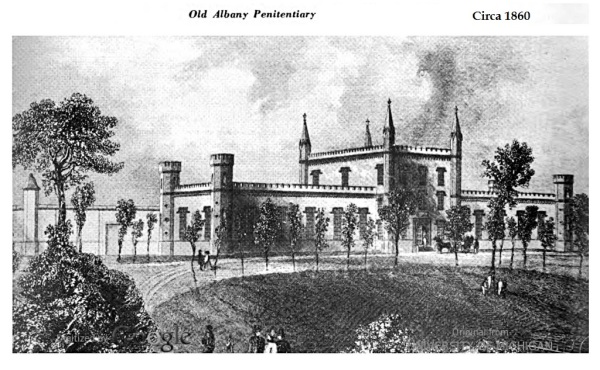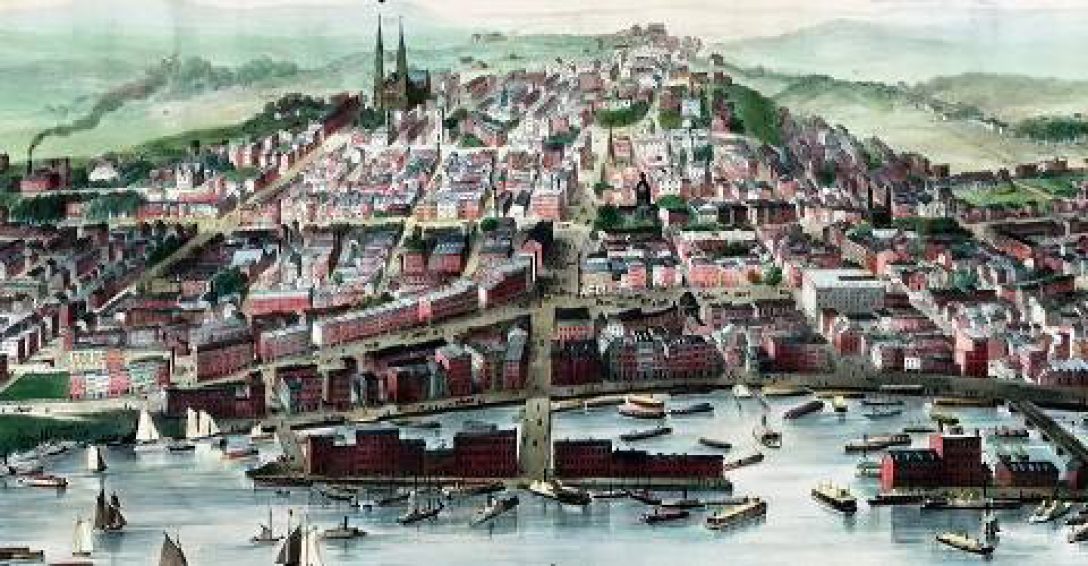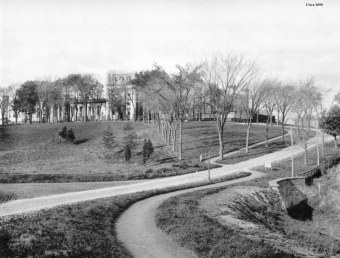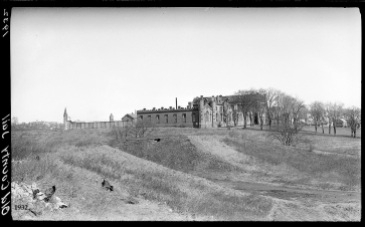
 With the old downtown Albany jail becoming inadequate to house what were characterized as “the vilest dregs of society, the rakings of the gutter and the brothel, the profligate, and even the diseased,” Albany County resolved in 1843 to create a new style of penitentiary aimed at “moral reformation of the convict,” but one where “labor performed in the prison shall produce a sufficient income for its maintenance.” With a state law authorizing construction in 1844, the new institution was sited just a few blocks south of what would become Washington Park, bounded by South Knox Street, Myrtle Avenue, Lark Street and Leonard Place, in lovely country environs.
With the old downtown Albany jail becoming inadequate to house what were characterized as “the vilest dregs of society, the rakings of the gutter and the brothel, the profligate, and even the diseased,” Albany County resolved in 1843 to create a new style of penitentiary aimed at “moral reformation of the convict,” but one where “labor performed in the prison shall produce a sufficient income for its maintenance.” With a state law authorizing construction in 1844, the new institution was sited just a few blocks south of what would become Washington Park, bounded by South Knox Street, Myrtle Avenue, Lark Street and Leonard Place, in lovely country environs.

For some it truly became a prison of their own making, as county prisoners from the old jail were put to work building the new one. They moved themselves in by 1846, and continued to build, including a women’s wing. When completed, the penitentiary covered 3 acres and enclosed by a 14-foot crenelated brick wall. It was so impressive it was referred to for generations as “the Castle on the Hill”. Surrounding the building were 12 acres of “well laid out grounds, ornamented with trees, shrubs and flowers with a meandering brooklet and wandering driveways and paths of approach.” For a fee of 25 cents visitors could stroll the gardens and enjoy the view from “Penitentiary Hill”.
The goal of the institution was to show not only that prisoners could earn their own keep, but that by making them busy they would not return to their criminal ways The Albany Penitentiary’s success as a model reformatory (whipping and the crucifix: no; cold shower punishment: yes) was quickly rewarded. The State Legislature passed a succession of laws permitting other counties to use the facility. The growing roster of inmates was put to work caning chairs and making inexpensive shoes. Female inmates worked doing laundry.

The Civil War threatened this model of penal self-sufficiency. Petty criminals were forgiven their sentences if they enlisted in the Union Army. The number of inmates fell and the southern market that supported the penitentiary’s shoe making factory disappeared. But penitentiary officials were alert to opportunities. When they learned that the District of Columbia’s penitentiary was being taken over by the United States Arsenal, they arranged for Albany to be the penitentiary for the District. This began in September 1862 with the transfer of 131 convicts, and continued for decades after the war ended; over time felons convicted in other federal courts were sent to Albany. . Confederate prisoners of war (including Samuel “One-Armed” Berry, one of Quantrill’s Raiders), Ku Klux Klan members, D.C. swindlers, Tom Ballard – the most famous counterfeiter of the 19th century, and petty criminals serving six months or less and guilty of such offenses as assault, horse theft, and indecent exposure, all ended up in the same institution.

The most famous convicts ever sentenced to time in Albany never arrived. Four of the convicted conspirators in the Lincoln assassination — Dr. Samuel Mudd, Edman Spangler, Samuel Arnold, and Michael O’Laughlen — were sentenced to Albany. They boarded a ship in the Potomac expecting a long trip north but were surprised to find themselves sailing to a military prison in the Dry Tortugas, islands at the end of the Florida Keys. Despite his cries of injustice at the sentencing, Dr. Mudd, convicted of conspiracy for setting John Wilkes Booth’s broken leg after the assassination, apparently found the extremely southern prison more to his liking. A friend wrote to Mudd’s daughter that, “He is doing a great deal better than he would have done at Albany.”

For decades the penitentiary made a tidy profit. But by the early 1900s, counties across the state were building their own penitentiaries and there was a growing Federal prison system – the penitentiary went into the red. The rapid explosion of residential development in the Delaware Ave. area and the conversion of the mostly wild and over grown Beaver Park to the community Lincoln Park in the early 1900s dictated a new location for the prison.
By 1920, plans were being made for a new penitentiary. But this is Albany, so things take time. Overcrowding in Albany city schools forced the issue. In 1927 William S. Hackett Jr. High School was built on the penitentiary grounds on Delaware Ave. The old Albany Penitentiary was finally closed after a new one opened in 1931, well out of the city, on Albany Shaker Road. The penitentiary was razed in 1933; the demolition crew found the remnants of underground dungeons with chains and manacles attached to the thick foundation walls. (So much for a model of modern prison reform.)
The City briefly considered building a new high school on the site, but decided to renovate existing School 14 in the South End to become Philip Schuyler High School. In 1941, the land was dedicated as the Hoogkamp (after the Mayor at the time) Girl Scout playground and camping area. That lasted for a nano until the outbreak of World War II, when area was given over to Victory Gardens. It was sold to the federal government in 1946 for the current V.A. Hospital, which opened in 1951.


Copyright 2021 Julie O’Connor








